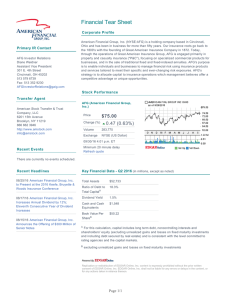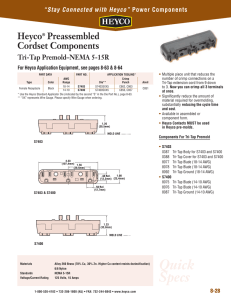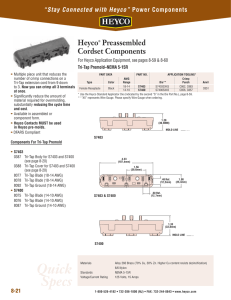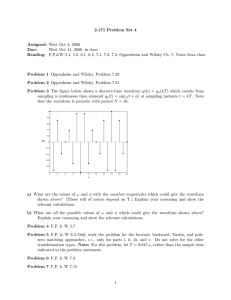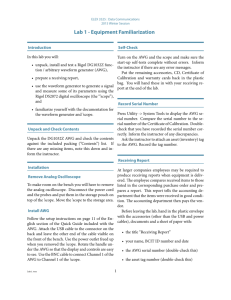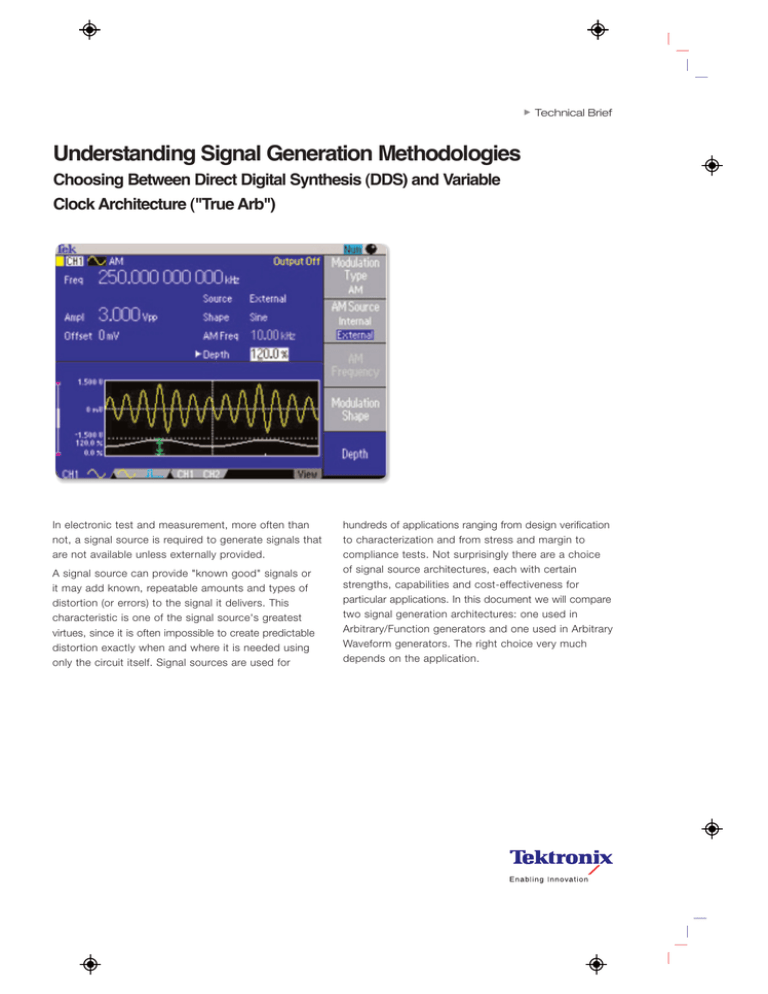
Technical Brief
Understanding Signal Generation Methodologies
Choosing Between Direct Digital Synthesis (DDS) and Variable
Clock Architecture ("True Arb")
In electronic test and measurement, more often than
not, a signal source is required to generate signals that
are not available unless externally provided.
A signal source can provide "known good" signals or
it may add known, repeatable amounts and types of
distortion (or errors) to the signal it delivers. This
characteristic is one of the signal source's greatest
virtues, since it is often impossible to create predictable
distortion exactly when and where it is needed using
only the circuit itself. Signal sources are used for
hundreds of applications ranging from design verification
to characterization and from stress and margin to
compliance tests. Not surprisingly there are a choice
of signal source architectures, each with certain
strengths, capabilities and cost-effectiveness for
particular applications. In this document we will compare
two signal generation architectures: one used in
Arbitrary/Function generators and one used in Arbitrary
Waveform generators. The right choice very much
depends on the application.
Understanding Signal Generation Methodologies
Technical Brief
Arbitrary/function generators (AFG) create both function
waveforms and arbitrary waveforms by reading the
contents of an internal memory. Most modern AFG’s
use direct digital synthesis (DDS) technology to deliver
signals over a broad range of frequencies.
Arbitrary waveform generators (AWG) based on a true
variable clock architecture (commonly referred to as
"true arbs*1") are favored for more complex waveform
generation at all frequencies. AWGs, too, read the
contents of an internal memory, but in a different way
(described later). Designers working with advanced
communications and computing elements choose
the AWG to drive high-speed signals with complex
modulation and anomalies. As a result, AWGs occupy
the highest tier of research, development, and
engineering applications.
The two architectures differ greatly in terms of their
waveform generation approach. This technical brief
discusses the differences between variable-clock-based
arbitrary waveform generators and DDS-based
arbitrary/function generators.
Behind the Front Panel: Comparing
the Platforms
AWG: Simple Concept, Maximum Flexibility
Though it is the more flexible of the two architectures,
the underlying waveform generation technique of the
AWG is straightforward. The AWG’s playback scheme
can be thought of as “sampling in reverse.”
What does that mean? Imagine an oscilloscope, the
ultimate sampling platform. It acquires a waveform by
digitizing the analog signal’s voltage value at a succession
of points in time, with the frequency of the sampling
being determined by the user-selected clock rate.
The resulting samples end up in a memory.
*1
The AWG reverses the process. The AWG starts with a
waveform already in its memory. The waveform occupies
a designated number of memory locations. With every
clock cycle, the instrument outputs another waveform
sample from the memory. Because the number of
samples representing the waveform is fixed, a faster
clock rate will read through the waveform data points in
memory more quickly, yielding a higher output frequency.
In other words, the output signal frequency depends
entirely on the clock frequency and the number of
waveform samples in memory*2. The simplified block
diagram in Figure 1 summarizes the AWG architecture.
The AWG’s flexibility comes from the waveform stored
in its memory. The waveform can take any shape; it can
have any number of aberrations, or none at all. With
the help of PC-based tools, users can develop literally
any wave shape the mind can conceive (within the
constraints of physics!). The samples can be read out of
the memory at any clock frequency the instrument is
capable of producing. The waveform will have the same
shape whether the clock is running at 1 MHz or 1 GHz.
Engineers often use the casual term “arb” when referring to any type of arbitrary waveform generation instrument.
*2 There
2
Figure 1. Simplified block diagram of the AWG architecture.
is of course a maximum memory capacity for any AWG model. The waveform can occupy less depth than the full capacity.
www.tektronix.com/signal_sources
Understanding Signal Generation Methodologies
Technical Brief
AFG Takes Efficient Shortcuts to High Frequency
The AFG, too, uses a stored waveform as the basis of
its output signal. A clock signal is involved in the readout
of the samples. But here the similarity ends.
The AFG’s clock runs at one fixed rate. Since the number
of waveform samples is also fixed in memory, how can
the AFG deliver the waveform at varying frequencies?
For example, imagine you were using an AFG with a
stored waveform consisting of 1000 samples that are
output at a fixed rate of 1 MHz. The period of the output
signal would be fixed at exactly 1 ms (1 kHz).
Obviously a single-frequency signal source would be of
limited use in most applications. So DDS technology
offers a solution. Instead of reading every sample, a
DDS-based instrument reconstructs the waveform by
reading fewer than 1000 samples.
Figure 2 depicts a typical AFG architecture, including
the DDS section, in simplified form. The output signal
is formed by the clock, a stored binary number
representing a phase value, and the contents of the
waveform memory.
As already explained, the AFG maintains a fixed system
clock frequency. The 360 degrees of a waveform cycle
are spread across the full number of waveform samples,
and the DDS section automatically determines the
phase increments based on the waveform length and
the frequency selected by the user.
High frequency settings result in large phase increments,
causing the AFG to skip ahead through the 360-degree
cycle quickly, delivering a high-frequency signal. Low
frequency values lead to small increments triggering
the phase accumulator to step through the waveform
samples at a slower pace and even repeat individual
samples to complete the 360 degrees, producing a
lower-frequency waveform.
Figure 2. Simplified block diagram of an AFG architecture.
The math behind all of this decision-making is beyond
the scope of this discussion. Suffice to say that the AFG
skips selected waveform data points based on its own
internal algorithms. Because of the phase increment
approach, it doesn’t always skip the same samples in
every cycle. The AFG offers an expedient way to produce
varied waveforms and frequencies, but the end-user
cannot control which data points are skipped.
This is bound to have some impact on output waveform
fidelity. Waveforms with continuous shapes—sines,
triangles, etc.—are usually not a problem but signals
with fast transitions like pulses and transients common
in today’s digital environment can be affected. Suppose,
for example, you are doing stress tests on a new component for a telecom switch. The test waveform is a
series of binary pulses, one of which has a transient on
the rising edge. At some frequencies the DDS phase
increments might skip right past the transient without
clocking it out as part of the signal. To the device under
test (DUT), the signal looks like an undisturbed pulse
stream and the stress test, lacking any actual “stress,”
is invalid.
www.tektronix.com/signal_sources
3
Understanding Signal Generation Methodologies
Technical Brief
AFG (DDS)
AWG
Sample Clock Rate
Fixed
Variable
Sample Increment
Varies automatically, depending
on output frequency setting
Fixed, 1 point per clock
Memory Depth
Fixed or variable
Variable
Table 1. AFG vs. AWG sampling characteristics.
The AFG architecture is less expensive to implement
than a full-featured AWG toolset. Consequently it is
affordable enough to be allocated to individual engineers
and researchers. And the AFG has some unique
performance advantages of its own. Some leading
models have the best frequency agility—the ability
to switch smoothly among different frequencies
without producing discontinuities in the signal—of
any waveform-generating platform.
Table 1 summarizes the clock and memory characteristics
of the AFG and AWG platforms.
Drilling Down to the Details
To better understand the contrast between AWG and
AFG architectures, a brief “case study” is in order. We
will look at the way in which the two platforms handle
the sample points that define the output waveforms.
There are three instruments in this comparison: an AFG
with a maximum sample rate of 1 GS/s; AWG #1 with a
maximum sample rate of 1 GS/s; and AWG #2 with a
maximum rate of 2 GS/s.
The object is to produce a sine wave at frequencies
ranging from 3 MHz to 20 MHz. Both of the AWGs and
the AFG are loaded with one cycle of the sine wave in
100 points of sample memory. Figure 3 shows how the
attributes of the three platforms affect the way they
handle the task.
All three tools can read through the 100 points at a
sample rate of 1 GS/s to produce the 10 MHz sine wave
(middle row in Figure 3):
4
www.tektronix.com/signal_sources
Figure 3. Three approaches to managing the frequency of the
output signal.
Instructed to deliver 10 MHz at the output, the AFG’s
DDS element calculates an increment of 1 point for
each tick of the 1 GS/s clock. It touches every one of
the 100 sample points.
The clocks in both of the AWG are manually set to
1 GS/s, and they too read the 100 points to generate
the 10 MHz waveform.
The methods diverge when you set the output frequency
to 3 MHz (bottom row):
The AFG’s clock still runs at its fixed 1 GS/s rate. But
now the DDS automatically sets the increments to
0.3 points per clock tick; that is, individual data
points are repeated three or four times.
The clock frequencies in both AWGs must be reduced
manually to 300 MS/s. The clock now reads through the
points more slowly, yielding the 3 MHz output frequency.
Understanding Signal Generation Methodologies
Technical Brief
Now the output frequency must be increased to 20 MHz.
Here all three platforms handle the challenge differently:
The AFG’s DDS element sets the sample increment
to two samples. It reads every other sample, using a
total of 50 points to define the waveform. This takes
only half as long as reading 100 points. The result is
a 20 MHz output signal.
AWG #1 reads one sample per clock tick, as do all
AWGs at any frequency setting. But because its
maximum sample rate is 1 GS/s, it can’t read 100
samples within the 50 ns period of a 20 MHz sine
wave cycle. Therefore, the stored waveform image
must be decreased by deliberate user intervention
to a total of 50 samples. The result is a 20 MHz
output signal.
Software tools are available to help users edit the
sample count when required, and some instruments
have built-in features for the purpose. When using
external tools, the modified waveform must be
reloaded into the AWG.
AWG #2 reads one sample per clock tick, but the
clock rate is doubled to 2 GS/s. The instrument
reads through its 100-point memory twice as fast.
The result is a 20 MHz output signal.
At first glance, it would appear that AWG #1 is limited to
the same waveform resolution as the AFG. But there is
a critical difference. At a 20 MHz output frequency, the
AWG is reading every single one of the 50 samples in
the sine wave. The AFG is skipping samples.
Figure 4. The AFG skips samples to increase its output frequency.
Individual signal details can be overlooked at some frequencies.
The AWG reads every point, red or black, irrespective of
the output frequency setting. If the output frequency is
set to 10 MHz, the AWG reads 25 points. If it is set to
20 MHz, the AWG still reads 25 points. If the maximum
clock rate within the AWG isn’t high enough to produce
the desired frequency by reading all of the points, then
the number of points can be reduced. Assuming that
the user pays attention to preserving the desired waveform characteristics when trimming the AWG’s sample
count, the instrument will reliably deliver the glitch once
in every cycle.
Now consider the AFG. If the output frequency is set to
10 MHz, it reads every point. If it is set to 20 MHz, it
reads every second point, nominally. These DDS points
are shown in red. Notice that the AFG completely
bypasses the glitch. It skips the very sample that defines
the dropout. The waveform goes out as a clean sine wave.
The device under test doesn’t receive the aberration.
Figure 4 illustrates the basic dichotomy between the
AFG/DDS and AWG approaches. The image depicts one
half-cycle of a sine wave consisting of 25 points, including
an aberration added to simulate a momentary dropout
on a DAC.
www.tektronix.com/signal_sources
5
Understanding Signal Generation Methodologies
Technical Brief
Figure 5. This sine wave signal from an AWG shows an aberration
in every cycle. The AWG is reading every sample in the memory,
which ensures that the aberration will repeat itself consistently.
Figure 7. 30 Mbps random pattern from an AWG running
at 30 MS/s.
Figure 6. This sine wave from an AFG fails to reproduce the
aberration on some cycles, because it is skipping the samples
that define the transient.
Figure 8. 30 Mbps random pattern from an AFG running at 250 MS/s.
The jitter value is the reciprocal of 250 MS/s., that is, 4 ns.
Signals that Include Aberrations
Pseudo-random Bit Stream (PRBS) Pattern Generation
Figure 4 is strictly a "textbook" example. Depending on
the algorithm and the frequencies involved, the DDS
will select different points to skip, so the dichotomy
between the red and black samples will not apply in
every case. Figures 5 and 6 are actual screen shots
that underscore the differences in the two sampling
and waveform reconstruction architectures.
Jitter is an issue when generating pseudo-random bit
stream (PRBS) pattern using a DDS-based AFG and its
fixed sample rate. Simply stated, the AFG tends to
apply one sample period worth of jitter to fast-changing
pulse edges both rising and falling*3. If, for example, the
AFG’s sample rate is 250 MS/s, then 4 ns of jitter will
appear on the signal edges. The jitter value is the same
as the sampling period of the AFG.
The jitter appears because the AFG has a fixed sampling
rate, which is not a multiple of the data rate. Here again,
the AWG is not subject to this limitation (although any
real-world signal source will produce some jitter).
*3
6
Sine waves and other signals with slower transktions are not affected.
www.tektronix.com/signal_sources
Understanding Signal Generation Methodologies
Technical Brief
Point/Counterpoint
As always, the ultimate choice of the tools depends on
the application. There is always a temptation to go for
the “best numbers,” which when applied to sample rate
and memory depth means the biggest numbers. Astute
users will instead make a choice compatible with the
application’s actual signal requirements.
For example, certain mid-range AFG’s offer 1 GS/s sample
rates while some AWGs in the same class are limited to
600 MS/s. But when the application requires reliable
delivery of small signal details at a wide range of
frequencies, the AWG is the preferred tool. Because the
AWG reads every sample point on the stored waveform,
you can be sure that transients, edge risetimes, and
even noise effects will be reproduced accurately.
Moreover, the AWG is the better tool for sourcing
low-jitter digital waveforms such as pseudo-random bit
streams (PRBS). That makes it the best solution for
many serial bus measurement applications.
Inevitably there are a few tradeoffs. Editing the number
of samples to increase the output frequency, as in the
case of AWG#1 described earlier, is less convenient
than the AFG method of changing one setting to alter
the frequency.
And because the AWG architecture relies on one variable master clock across all of its channels, generating
differing frequencies simultaneously across several
channels requires storing a different waveform file
behind each channel.
If there is a need, for example, to generate a 10 MHz
sine from Channel 1 and at the same time a 20 MHz
sine wave from Channel 2, then the Channel 2 waveform memory must be loaded with two cycles.
Therefore, when the clock steps through the memory,
two cycles will emerge from Channel 2 for every single
cycle from Channel 1, doubling the output frequency.
This process grows more complicated when the differing
frequencies are not simple multiples of the base frequency.
The AFG offers a different set of strong points. Its phase
noise specifications and frequency agility tend to be
superior to those in AWGs. In some leading AFG models,
the master clock is manipulated independently by the
DDS element in each channel, making it easy to deliver
multiple frequencies at once. And AFG’s are usually the
most affordable solution among the available choices.
Arbitrary function generators have become the mainstay
of general-purpose signal sources.
The AFG is less suited to applications requiring low jitter
and very narrow transients. The platform may not suffice
for PRBS applications since the innately higher jitter on
its output waveform can cause an erratic response in
DUT receiving elements. And for stress tests requiring
predictable signal distortions, the AFG’s sampleskipping technique can produce misleading results
at some frequencies.
Conclusion
As is often the case, the choice between the AFG and
the AWG is one of selecting the most appropriate of two
strong contenders.
Choose the AFG when the application calls for clean,
regular waveforms, and/or fast switching from
frequency to frequency, or when multiple channels
must deliver differing frequencies simultaneously.
Choose the AWG for the most complex signals:
PRBS streams, modulated RF signals, and more.
When the source must reliably produce aberrations,
controlled jitter, and noise in every operational cycle at
every available frequency, the AWG is the better tool.
www.tektronix.com/signal_sources
7
Contact Tektronix:
ASEAN / Australasia (65) 6356 3900
Austria +41 52 675 3777
Balkan, Israel, South Africa and other ISE Countries +41 52 675 3777
Belgium 07 81 60166
Brazil & South America 55 (11) 3741-8360
Canada 1 (800) 661-5625
Central East Europe, Ukraine and the Baltics +41 52 675 3777
Central Europe & Greece +41 52 675 3777
Denmark +45 80 88 1401
Finland +41 52 675 3777
France +33 (0) 1 69 86 81 81
Germany +49 (221) 94 77 400
Hong Kong (852) 2585-6688
India (91) 80-22275577
Italy +39 (02) 25086 1
Japan 81 (3) 6714-3010
Luxembourg +44 (0) 1344 392400
Mexico, Central America & Caribbean 52 (55) 5424700
Middle East, Asia and North Africa +41 52 675 3777
The Netherlands 090 02 021797
Norway 800 16098
People’s Republic of China 86 (10) 6235 1230
Poland +41 52 675 3777
Portugal 80 08 12370
Republic of Korea 82 (2) 528-5299
Russia & CIS +7 (495) 7484900
South Africa +27 11 254 8360
Spain (+34) 901 988 054
Sweden 020 08 80371
Switzerland +41 52 675 3777
Taiwan 886 (2) 2722-9622
United Kingdom & Eire +44 (0) 1344 392400
USA 1 (800) 426-2200
For other areas contact Tektronix, Inc. at: 1 (503) 627-7111
Updated 12 May 2006
Our most up-to-date product information is available at: www.tektronix.com
Copyright © 2006, Tektronix. All rights reserved. Tektronix products are covered by U.S. and foreign
patents, issued and pending. Information in this publication supersedes that in all previously
published material. Specification and price change privileges reserved. TEKTRONIX and TEK are
registered trademarks of Tektronix, Inc. All other trade names referenced are the service marks,
trademarks or registered trademarks of their respective companies.
7/06 JS/WOW
76W-19764-1

